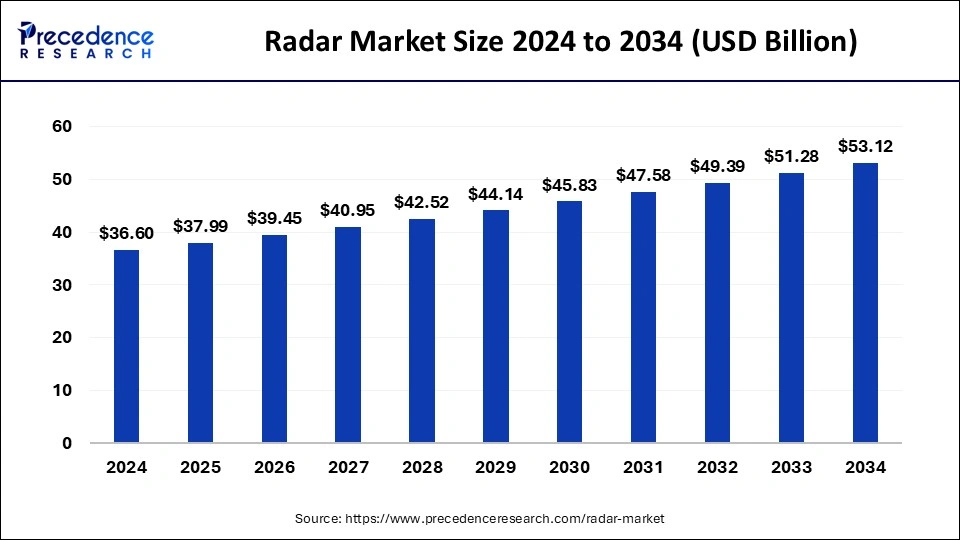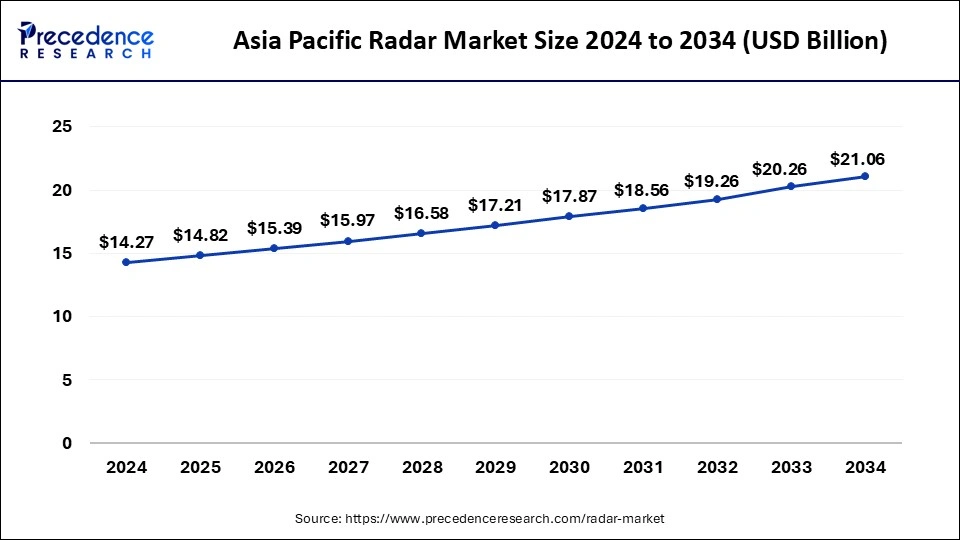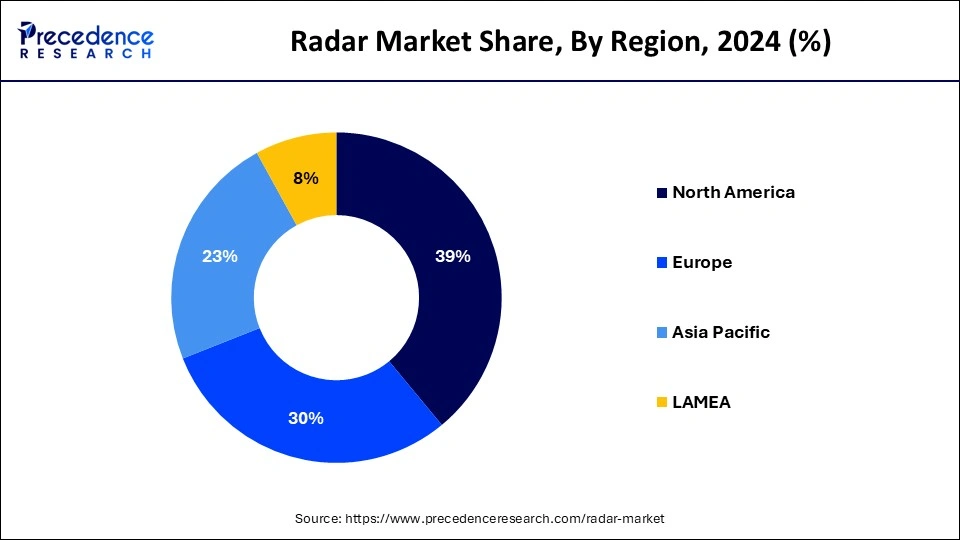The global radar market size is calculated at USD 37.99 billion in 2025 and is forecasted to reach around USD 53.12 billion by 2034, accelerating at a CAGR of 3.80% from 2025 to 2034. The Asia Pacific market size surpassed USD 14.27 billion in 2024 and is expanding at a CAGR of 3.97% during the forecast period. The market sizing and forecasts are revenue-based (USD Million/Billion), with 2024 as the base year.
The global radar market size accounted for USD 36.60 billion in 2024 and is predicted to increase from USD 37.99 billion in 2025 to approximately USD 53.12 billion by 2034, expanding at a CAGR of 3.80% from 2025 to 2034. The growing terrorist activities, inter-country conflicts, and border infiltrations are considerably driving the demand for the radar market.

The Asia Pacific radar market size was exhibited at USD 14.27 billion in 2024 and is projected to be worth around USD 21.06 billion by 2034, growing at a CAGR of 3.97% from 2025 to 2034.

Asia Pacific dominated the radar market in 2024. Factors such as rapid economic development, increasing defense spending, and persistent geopolitical tensions are driving market growth in this region. Major contributors to this growth include countries like China, India, and Japan. Furthermore, the availability of funding and investments is expected to further boost the regional market. A significant ongoing trend in the Asia Pacific defense sector is research and development.

North America is projected to witness the fastest growth in the radar market over the forecast period. Major manufacturers invest in R&D to develop advanced radar solutions, driving the global market. Leading defense contractors and substantial government defense spending can fuel market growth. The region's strong market position is attributed to its emphasis on radar system innovation, particularly for military and air traffic control applications.
Radar production in the United States is driven by advanced technology and a robust defense sector. Radar is essential for space exploration, including asteroid tracking and planet mapping. Space agencies like NASA and the military regularly rely on radar technology for their missions. A large defense budget and cutting-edge defense capabilities contribute to the country's superior defense. Government spending and leading defense contractors further stimulate the radar market growth.
The radar market encompasses the creation, distribution, and application of radar systems across numerous global industries. These systems, which utilize radio waves to identify, track, and observe objects such as vehicles, airplanes, ships, and weather phenomena, are important for maritime navigation, weather prediction, military defense, air traffic management, and vehicle safety. This market includes various radar types, including weather, marine, surveillance, and automotive radar. Advances in technology, such as the incorporation of artificial intelligence, machine learning, and digital signal processing, fuel innovation in the radar sector by improving the precision, range, and functionality of radar systems.
| Report Coverage | Details |
| Market Size by 2034 | USD 53.12 Billion |
| Market Size in 2025 | USD 37.99 Billion |
| Market Size in 2024 | USD 36.60 Billion |
| Market Growth Rate from 2025 to 2034 | CAGR of 3.80% |
| Largest Market | Asia Pacific |
| Base Year | 2024 |
| Forecast Period | 2025 to 2034 |
| Segments Covered | Component, Service, Platform, Frequency Band, Range, End-use, and Regions |
| Regions Covered | North America, Europe, Asia-Pacific, Latin America, and Middle East & Africa |
Use of AI technology in radar manufacturing
The growing market for UAVs is fueled by radar technology, which is used for navigation, collision avoidance, and real-time area monitoring. These factors drive the expansion and diversification of the radar market. Technological advancements and increased applications across various industries continue to create opportunities for radar system manufacturers and developers. Furthermore, Companies are leveraging AI technologies to develop radars for various industrial applications. A significant technological advancement has been the development of laser radar, which is particularly suited for automotive applications.
Technical challenges associated with radar systems
A significant challenge in the radar market is the technical difficulties associated with radar systems. Issues like incompatibility between transmitter power and antenna size can compromise performance. High receiver noise and poor sensitivity can also limit effectiveness in certain scenarios. Overcoming these technical limitations requires ongoing research and development, which can be time-consuming and costly.
Adoption of digital beamforming technology
The integration of digital beamforming technology allows for electronic control of radar beams and offers benefits like better target detection, improved tracking, and increased flexibility in beam management. This trend is propelled by the growing need for the radar market products that can adapt to changing conditions, provide multiple functions, and support advanced signal processing methods. Digital beamforming technology also facilitates the efficient use of radar resources by enabling rapid scanning, electronic steering, and the simultaneous tracking of multiple targets.
The antenna segment dominated the radar market in 2023. The growth of this segment can be attributed to the rising demand for digital signal processing. Additionally, the increasing deployment of radar systems worldwide and the upgrading of existing systems are expected to create a strong demand for antennas in the global market.
The transmitters segment is projected to grow at the fastest rate in the radar market over the forecast period. This is because Transmitters are important in radar system design, generating short, high-power radio-frequency pulses. These pulses are emitted by antennas. The two main types of transmitters used in radar systems are power oscillator transmitters (POT) and power amplifier transmitters (PAT).
the installation/integration segment led the radar market in 2023. A long-range radar system is installed to detect enemy structures and units. it can differentiate between ground and air units but cannot identify types of units. The demand for specialized vehicles along with radar mounting systems is expected to grow during the forecast period, which can drive segment growth.
The support & maintenance segment is expected to show the fastest growth in the radar market over the forecast period. Segment growth is also influenced by the pace of radar deployment and the anticipated continuation of this trend. Furthermore, the intricate design and operations of radar systems require regular maintenance, including the use of dry-air and liquid cooling systems.
The long segment dominated the radar market in 2023. This is because Long-range radars are extensively employed in the aerospace and defense industries. They are deployed for surveillance purposes, including detecting weapons and pinpointing targets within the defense sector. The increasing defense spending of countries like Brazil, Russia, and India is generating opportunities for segment growth.
The medium radar segment will experience the fastest growth in the radar market throughout the forecast period. The Aptiv MRR (medium-range RADAR) is designed to detect various targets, such as pedestrians, bicycles, motorcycles, cars, and trucks in front of a host vehicle. Technological advancements drive innovation, improve product offerings, and enhance operational efficiencies. These RADAR systems are also deployed in groups, overwhelming defenses, and their high maneuverability allows them to fly at lower altitudes than other airborne threats and maintain stealth for extended durations.
The military applications segment dominated the radar market in 2023. Radar systems are crucial in defense and military operations, offering vital functions like surveillance, target detection, tracking, and missile guidance. They are used for purposes such as air defense, border surveillance, maritime monitoring, and battlefield awareness. Given ongoing geopolitical tensions and rising defense expenditures globally, there continues to be strong demand for radar systems in the defense and military sectors.
The air traffic control segment is expected to grow at the fastest rate in the radar market during the projected period. The frequency of cargo planes and flights is expected to grow exponentially during this period. Moreover, rising air traffic requires an efficient traffic control system to prevent fatal events. These factors can boost the growth of the segment.
By Component
By Service
By Platform
By Frequency Band
By Range
By End-use
By Geography
For inquiries regarding discounts, bulk purchases, or customization requests, please contact us at sales@precedenceresearch.com
No cookie-cutter, only authentic analysis – take the 1st step to become a Precedence Research client